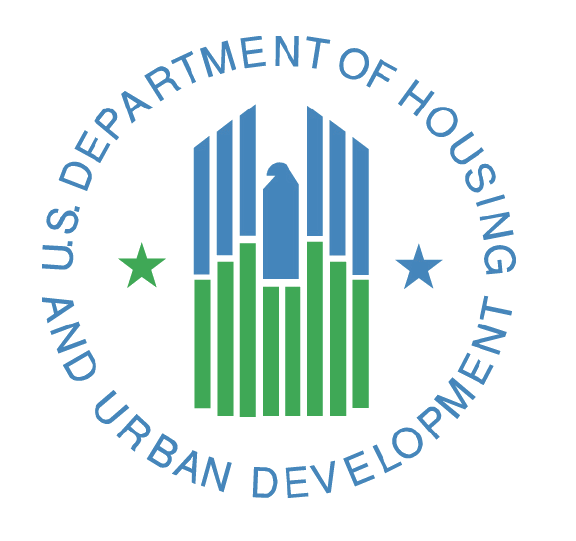
Housing Finance Reform Plan
Pursuant to the Presidential Memorandum Issued
March 27, 2019
September 2019

i
Contents
Executive Summary ................................................................................................................... 1
Introduction ................................................................................................................................ 4
A. FHA Background ..................................................................................................... 5
B. GNMA Background ................................................................................................. 6
I. Refocus FHA to its Core Mission ................................................................................... 8
A. Targeting Programs to Borrowers Not Served by Traditional Underwriting ........... 8
B. Define Roles for Government-Supported Programs Through Better Coordination12
C. Strengthening FHA Single-Family Default Servicing Processes ........................... 13
D. Ensure HUD’s Multifamily Programs are Appropriately Targeted ....................... 15
E. Provide Regulatory Certainty to FHA Lenders ...................................................... 16
II. Protect American Taxpayers ........................................................................................ 18
A. Strengthen FHA Risk Management Systems and Governance .............................. 18
B. Improve Financial Viability of the Home Equity Conversion Mortgage Program 19
C. Implement Tiered Pricing to Protect the MMIF ..................................................... 20
D. Eliminating Regulatory Barriers to Affordable Housing Including Manufactured
Housing .................................................................................................................. 20
III. Provide FHA and GNMA the Tools to Appropriately Manage Risk ....................... 23
A. Establish FHA as an Autonomous Corporation within HUD ................................ 23
B. Hire and Retain the Right Talent to Mitigate Risks to Taxpayers ......................... 23
C. Align Contracting and Procurement Processes with Business Needs .................... 23
D. Modernize FHA Technology .................................................................................. 24
E. Realign Housing Assistance Programs into a New Office of Rental Subsidy and
Asset Oversight within HUD ................................................................................. 25
IV. Provide Liquidity to the Housing Finance System ..................................................... 27
A. Advance GNMA Counterparty Risk Management and Securitization Platform
Transformation ....................................................................................................... 28
B. Guaranty Fee-setting Flexibility ............................................................................. 29
C. Reforms to Maintain the Integrity of GNMA Securities ........................................ 30
Conclusion ................................................................................................................................ 31
Appendix A ................................................................................................................................... I

1
Executive Summary
1. Refocus FHA to its Core Mission
The financial crisis resulted in private capital receding from the housing finance system. As a
result of the crisis and subsequent policy decisions of the previous Administration, the market
share of the Federal Housing Administration’s (FHA) increased dramatically from pre-crisis
levels. As the United States Department of Housing and Urban Development (HUD) pursues
reforms, FHA should refocus on its mission of providing housing finance support to low- and
moderate-income families that cannot be fulfilled through traditional underwriting, including
targeting first-time and lower-wealth creditworthy homebuyers who benefit from FHA’s ability
to provide affordable mortgage credit at fixed rates with lower down payments.
Since the financial crisis, the risk profile of FHA’s portfolio has increased steadily, endangering
FHA’s ability to support access to affordable mortgage credit for first-time homebuyers
(FTHBs). Credit scores of borrowers have fallen, while loan-to-value (LTV) and debt-to-income
(DTI) ratios have increased. The use of downpayment assistance (DPA) programs also has
grown significantly. Further, FHA’s activities have strayed away from its core mission—through
July of FY2019, 70 percent of FHA refinance endorsements are cash-out refinancing and FHA
remains the largest insurer of reverse mortgage products through its Home Equity Conversion
Mortgage (HECM) program. These activities create risks to the solvency of FHA and interfere
with its core mission of helping low- and moderate-income borrowers with good credit – yet
limited assets – afford a home and build wealth.
Through a formalized collaborative approach, FHA and the Federal Housing Finance Agency
(FHFA) must work together to ensure that government-supported mortgage programs are not
competing and do not crowd private capital out of the marketplace, both in their Single Family
and Multifamily programs. Further, FHA must ensure that borrowers are creditworthy and that
they have access to loans that meet their financial needs without creating undue risk. A mortgage
product that is inappropriate for a borrower may lead to default and foreclosure, destroy credit,
and exacerbate affordable housing need.
FHA must continue to have a strong enforcement regime that appropriately punishes bad actors
and those who willingly defraud taxpayers. However, its enforcement regime should not deter
reputable and well-regulated lenders from participating in FHA’s programs. Accordingly, it must
provide clarity and transparency in its regulatory expectations for participating lenders, including
addressing lender and loan-level certification standards and the defect taxonomy. In
collaboration with the Department of Justice (DOJ), FHA should continue to work to provide
more clarity on how the agencies will consult on the appropriate use of the False Claims Act
(FCA), which has driven away many lenders, including many depository institutions, from the
FHA program. FHA must ensure it continues to appropriately use all enforcement remedies and
mechanisms available. Doing so will provide lenders with transparency and a higher level of
certainty and promote the participation of a more diverse lender base in FHA’s programs.

2
2. Protect American Taxpayers
With mortgage insurance on loans of over $1.4 trillion in unpaid principal balance (UPB) and
more than $2.1 trillion in mortgage-backed securities (MBS) guaranteed by the full faith and
credit of the United States, FHA and the Government National Mortgage Association (GNMA),
respectively, must ensure their business and operational practices protect American taxpayers.
Meeting this duty also is essential to FHA’s and GNMA’s respective missions and if either does
not operate in a fiscally responsible manner, HUD’s ability to provide affordable and sustainable
mortgage credit for borrowers is severely jeopardized. FHA must maintain an appropriate level
of capital reserves in the Mutual Mortgage Insurance Fund (MMIF). It is unacceptable for FHA
to require a draw on taxpayer funds to sustain its book of business and so FHA should seek to
build its capital ratio well above the statutory two percent minimum to ensure that it is able to
weather stress events without requiring a taxpayer bailout.
FHA’s risk management capabilities must be improved in order to prudently serve its core
mission and to protect taxpayers. In particular, FHA must transform its data analytics and risk
management capabilities. FHA also must continue to develop policies that ensure its reverse
mortgage product – HECM, which has cost the MMIF billions of dollars in claims in recent
years – is fiscally sustainable. To ensure that HUD and taxpayers are properly compensated for
riskier loans, FHA should implement a “tiered pricing” framework to protect the MMIF.
FHA and GNMA must ensure that they can properly manage their counterparty risk exposure
and strengthen surveillance practices. To achieve this strategic aim, FHA and GNMA should
continue to work with FHFA and other federal entities to institute a framework that allows for
ongoing coordination and evaluation of housing finance policies to ensure proper alignment
across taxpayer-supported segments of the nation’s housing finance system. GNMA must also
evaluate its counterparties and their ability to withstand the stress inherent to changing
conditions in the financial markets.
3. Provide FHA and GNMA the Tools to Appropriately Manage Risk
FHA’s and GNMA’s respective footprints have increased significantly over the last decade—
FHA has become the world’s largest insurer of mortgages, insuring over $1.4 trillion of
mortgage loans on single-family homes, multifamily properties, and healthcare facilities. The
experience of the financial crisis exposed the importance of improving the operational
capabilities of FHA and GNMA and their critical need to have some autonomy and greater
flexibility in hiring and procurement.
Today, FHA relies upon 40-year-old technology requirements that inhibit responsiveness to
sudden market changes. To modernize FHA, Congress should re-charter it as an autonomous
government corporation within HUD, which would provide the agency tools and resources
necessary to make appropriate risk decisions to respond to changing markets. It is crucial FHA
and GNMA have the appropriate tools to manage risk and both agencies must be given resources
to hire and compensate talent with specialized expertise in the mortgage finance, risk
management, and MBS markets. These reforms will help FHA prevent foreclosures and
minimize risk of a taxpayer bailout in times of economic stress in the housing market.

3
4. Provide Liquidity to the Housing Finance System
GNMA securitization helps provide liquidity in the mortgage credit market to support the
objectives of FHA, the United States Department of Agriculture (USDA), and the United States
Department of Veterans Affairs (VA) mortgage insurance programs. During the last 10 years, the
size of the GNMA guaranty program has increased in size from less than $500 billion in 2008 to
almost $2.1 trillion today.
Currently, GNMA’s technology platform is secure and robust. As outlined in the U.S.
Department of the Treasury’s housing finance reform plan, if Congress should authorize it,
GNMA could provide an explicit, paid-for guaranty of the timely payment of principal and
interest on qualifying MBS that are guaranteed by the GSEs and any potential competitor
guarantors that might be chartered by FHFA. In recognition of its increased size and a potential
expansion of its role, GNMA must also ensure that program participation requirements mitigate
risk to the Federal Government. In support of this goal, GNMA must use its authorities to end
lender practices, such as loan “churning,” that increase the cost of mortgage credit for borrowers
utilizing FHA, USDA, and VA mortgage insurance.

4
Introduction
In the wake of the financial crisis, the dream of homeownership receded for many Americans.
Today, however, lower taxes and the elimination of unnecessary government regulations have
created an economic renaissance, making homeownership less of a dream and more of a
possibility. As a direct result of the Trump Administration’s pro-growth policies, unemployment
is at a 50-year low,
1
and American families are earning higher incomes and enjoying more
opportunities than seemed possible just a few years ago.
Yet, there is still one piece of unfinished business from the 2007-2008 financial crisis: housing
finance reform. Due to government policies that encouraged risky lending and created moral
hazard by building expectations that the Federal Government would bail out failing firms, the
housing finance system was a central cause of the financial crisis. This system must be reformed
and it is long overdue.
HUD plays a critical role in the nation’s housing finance system—FHA provides credit
enhancement and regulatory oversight for a portfolio exceeding $1.4 trillion and GNMA
guarantees more than $2 trillion in MBS, with the full faith and credit of the United States of
America. The symbiosis between the government-insured mortgage programs at FHA, the
USDA, and the VA – with GNMA-guaranteed MBS – contributes to lower-cost mortgage credit
and more affordable homeownership opportunities for creditworthy American borrowers.
As recognized in the March 27, 2019 Presidential Memorandum on Federal Housing Finance
Reform (Presidential Memorandum), HUD plays an integral role in the nation’s housing finance
system. During the financial crisis, and after due to the policies of the previous Administration,
FHA’s and GNMA’s balance sheets swelled, growing by approximately 350 percent and 400
percent, respectively, between FY2007 and FY2018. While FHA and GNMA are designed to be
countercyclical, their balance sheets remain at substantially elevated levels and expose taxpayers
to significant risks. In the event of a potential downturn in the housing market, FHA and GNMA
may incur serious losses, inhibiting their ability to support the housing market and increasing the
likelihood of a taxpayer-funded bailout. When the mortgage market contracts and private capital
recedes, HUD must maintain stability in the nation’s housing finance system by continuing to
serve as a countercyclical buffer. When the economy is strong and markets are well-functioning,
HUD must avoid competing with other government-supported programs and private capital, and
take steps to provide housing finance support to low- and moderate-income families that cannot
be fulfilled through traditional underwriting.
Accordingly, now is the time to refocus FHA and GNMA to their core missions and make sure
they have the tools needed to manage their significant portfolios. Both organizations face
challenges, including FHA’s legacy information technology (IT) platforms and processes, the
need for enhanced data analytics to support enhanced risk management, and perhaps most
importantly, critical limitations on the ability to innovate and decisively react to changing market
conditions to prevent taxpayer losses.
1
Bureau of Labor Statistics, April 2019 Household Survey (Apr. 2019),
https://www.bls.gov/news.release/pdf/empsit.pdf

5
Reform will reduce the Federal Government’s outsized role in housing finance and prevent its
activities from crowding out the private sector. Consistent with the goals set forth in the
Presidential Memorandum, this plan presents a unique opportunity to define an appropriate role
for HUD that refocuses FHA and GNMA on their core missions. By doing so, FHA and GNMA
will be better positioned to help low- and moderate-income families become sustainable
homeowners, build equity and wealth, and enable FHA and GNMA to act in a countercyclical
manner in the event there is an economic downturn without the risk of a taxpayer-funded bailout.
A. FHA Background
FHA’s origin traces back to the Great Depression when Congress authorized its creation under
the National Housing Act of 1934. The FHA of the 1930s served the same primary function as it
does today: providing insurance coverage against losses on mortgages originated by FHA-
approved lenders. Then, as in subsequent periods of market distress, FHA’s mortgage insurance
program has provided stability to the housing market and increased capital liquidity for home
buying and construction.
FHA mortgage insurance eliminates the need for lenders to charge additional risk premiums. The
reduction in risk allows lenders to offer affordable mortgage credit, expanding homeownership
to low- and moderate-income families that cannot be fulfilled through traditional underwriting.
FHA particularly benefits low- and moderate-income and FTHBs who may have good credit and
income sufficient to support a mortgage, but not the assets to cover more than FHA’s 3.5 percent
minimum down payment requirement. In return for the benefits of mortgage insurance coverage,
borrowers pay mortgage insurance premiums. FHA must generate enough premium revenue (and
interest thereon) to cover expected losses and maintain the minimum capital reserve ratio of two
percent required by statute.
During the financial crisis, FHA served as a countercyclical buffer in the nation’s mortgage
finance system by expanding to support the stability of the housing market during and after the
financial crisis. When private capital largely withdrew from the housing finance system, FHA’s
share of mortgages for home purchase (as opposed to refinance mortgages) expanded to a peak
of nearly 30 percent. FHA’s single-family housing portfolio grew considerably in the wake of
the financial crisis, reaching a high of 1,831,234 endorsements in FY2009 and remains at an
elevated level. FHA endorsed 1,014,583 loans in FY2018. Today, FHA insures over 8.1 million
forward and nearly 500,000 reverse single-family mortgages with more than $1.2 trillion in UPB.
When FHA’s multifamily and healthcare programs are included, the total UPB is $1.425 trillion.

6
Figure 1
While FHA was created to counter the collapse of the housing finance market during the Great
Depression, its mission now includes the promotion of affordable housing opportunities and
homeownership, specifically for buyers not served by traditional underwriting. Then, as now,
FHA facilitated access to credit for borrowers from lenders and also increased investor
confidence to purchase mortgages.
B. GNMA Background
Since 1968, when Congress authorized the creation of the agency, GNMA has played a central
role in the development of the U.S. mortgage securitization system. Then, as now, GNMA
effectuates its mission by providing a full faith and credit of the United States guaranty of the
timely payment of principal and interest to security holders of MBS backed by pools of
mortgages insured or guaranteed by federal agencies, including FHA, VA, and USDA. GNMA
does not originate mortgages and does not issue MBS—it relies on issuers that are approved
financial institutions to pool or securitize eligible mortgages, either originated or acquired by the
issuers to issue GNMA-guaranteed MBS. The GNMA MBS guaranty program supports single-
family forward residential mortgages, single-family reverse mortgages through the Home Equity
Conversion Mortgage MBS (HMBS) program, and mortgages secured by multifamily and
healthcare properties, and manufactured housing.
Following the financial crisis, GNMA’s outstanding MBS portfolio has increased nearly fourfold
to over $2.1 trillion concurrent with growth in the combined mortgage insurance and guaranty
programs of FHA and VA. The market was able to absorb this substantial growth, which has
been supported through investor demand for alternative full faith and credit instruments (i.e.,
U.S. Treasuries). The “last position” guaranty in mortgage securitization that GNMA covers in
7
its MBS guaranty program is an important element of potential reform of the broader housing
finance system. As described in the U.S. Department of the Treasury’s housing reform report
also required pursuant to the Presidential Memorandum, GNMA could – if authorized by
Congress – extend its explicit guaranty to MBS backed by conventional and multifamily
mortgage loans, as it already has experience in marketing and administering MBS guaranty
programs.

8
I. Refocus FHA to its Core Mission
A. Targeting Programs to Borrowers Not Served by Traditional Underwriting
Following the crisis, FHA’s market share increased dramatically while its risk profile has
degraded and activities beyond serving its mission borrowers expanded. FHA should refocus its
single-family housing mortgage insurance program on low- and moderate-income families,
including FTHBs, who cannot affordably access credit through traditional underwriting. Doing
so will strengthen FHA’s ability to help these borrowers build equity, avoid foreclosure, and
protect taxpayers.
Generally, FHA facilitates earlier entry points into homeownership for FTHBs than conventional
mortgage loans. This is FHA’s most important contribution to the American housing market. The
share of FHA-insured purchase mortgage activity for FTHBs has ranged between 75 percent in
FY2011 and 83 percent in FY2018. Without FHA insurance, many of FHA’s low- and moderate-
income, minority, and FTHBs would lack access to affordable mortgage credit. The benchmark
for success of FHA’s programs should be ensuring that borrowers are receiving financing that is
appropriate, sustainable, and optimized for long-term homeownership.
Despite the current strong economy, the credit risk profile of the average FHA FTHB has
deteriorated in recent years. Additionally, the average original loan amount for an FHA borrower
has increased steadily, from just over $140,000 in FY2011 to over $183,000 in FY2018, which
has led to an increase in DTI ratios, as home prices generally have increased faster than wages.
The average DTI for FHA purchase borrowers reached a post-crisis low in FY2013 of 40.02
percent, but has steadily increased, reaching 43.90 percent by FY2018. Moreover, nearly 24.80
percent of purchase loans in FY2018 had a DTI ratio greater than 50 percent, up from 13.54
percent in FY2013. In addition, average credit scores for FTHBs in the FHA program have
deteriorated, decreasing from 687 in FY2010 to 664 in FY 2018. Collectively, these borrower
attributes jeopardize the strength of FHA’s single-family portfolio.
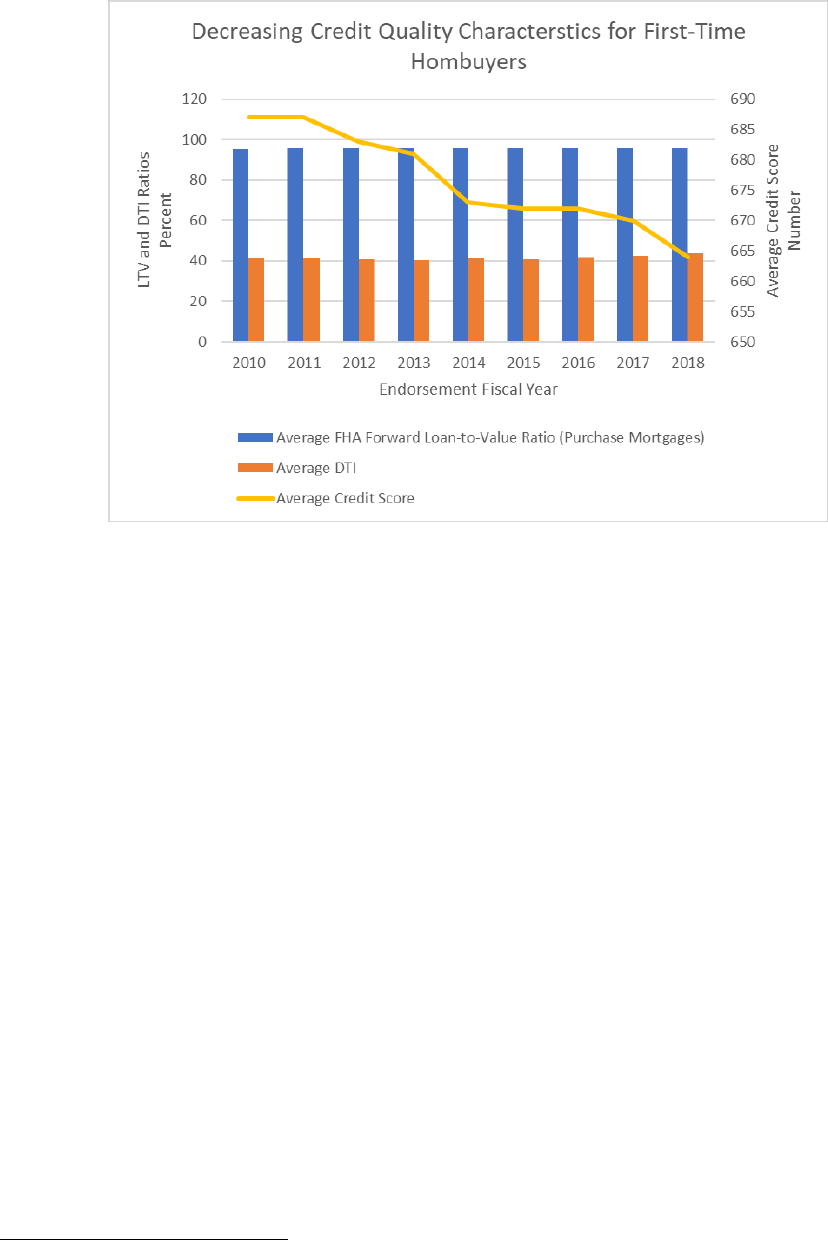
9
Figure 2
FHA has grown concerned as an increasing number of borrowers have used the FHA program to
extract equity from their homes. Some portion of FHA-insured mortgage loans are to borrowers
who currently have or previously had an FHA-insured mortgage loan. FHA should assess repeat
FHA borrowers to ensure these mortgage loans are consistent with FHA’s mission. The FY2018
cash-out refinance volume of 150,883 loans was the highest reported since 2009.
2
In FY2018,
cash-out refinance transactions represented 63.31 percent of all FHA refinance transactions, a
substantial increase from the FY2017 level of 38.94 percent.
Particularly troubling is the number of FHA cash-out refinances of conventional loans. In
FY2018, 35.05 percent of all FHA refinances were conventional to FHA cash-out refinances up
from 23.38 percent in FY2017. On August 1, 2019, FHA took steps to curb the increase in cash-
out refinancing within its single-family portfolio by limiting refinances to 80 percent LTV,
matching the GSEs’ requirements. FHA should continue to monitor its cash-out refinance
business closely to determine whether further action is necessary.
2
U.S. Department of Housing and Urban Development (2018): Annual Report to Congress Regarding the Financial
Status of the FHA Mutual Insurance Fund.
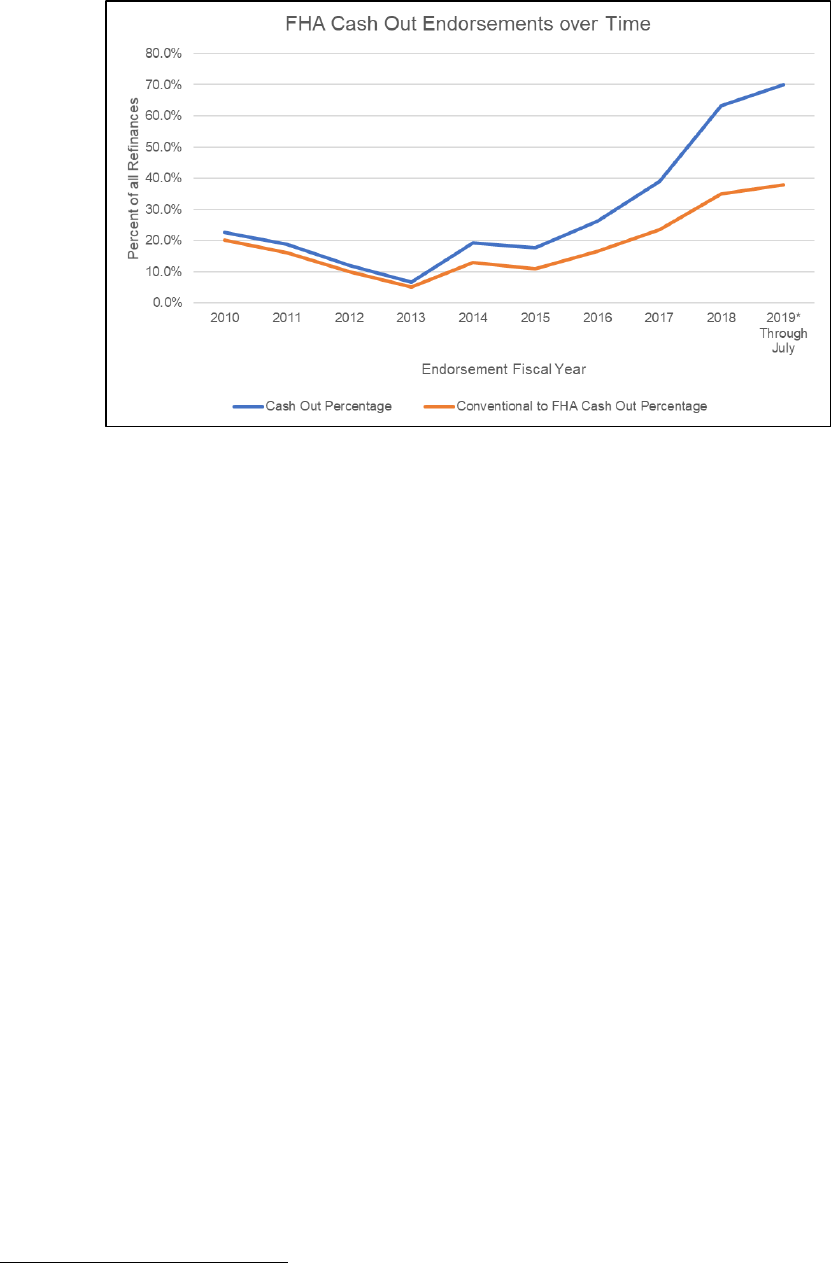
10
Figure 3
Also of significant concern is the increasing share of FTHBs relying on DPA to finance their
purchases. In FY2018, approximately 43 percent of FTHBs relied on some form of DPA. This is
the highest post-crisis share when only 34 percent in FY2010 used some form of DPA.
Moreover, the average amount of DPA has increased over this period from $6,667 in FY2010 to
$8,232 in FY2018.
FHA continues to monitor purchase mortgages with DPA given the additional risk in these loans.
FHA loan performance data indicate that mortgages with DPA have higher early payment default
(EPD) and serious delinquency (SDQ) rates than those without such assistance.
3
The SDQ rates
for FY2018 endorsements with government-funded DPA were nearly double those without any
form of DPA, and those with DPA covered either by a relative or other source performed only a
few basis points better than the government-financed DPA loans. Given the higher EPD and
SDQ rates associated with loans with government DPA, FHA will evaluate whether its current
premium structure for these loans is commensurate with the risk taxpayers are taking on. It also
is important that any DPA provided with respect to FHA loans complies with all legal
requirements.
3
Id. at 38.
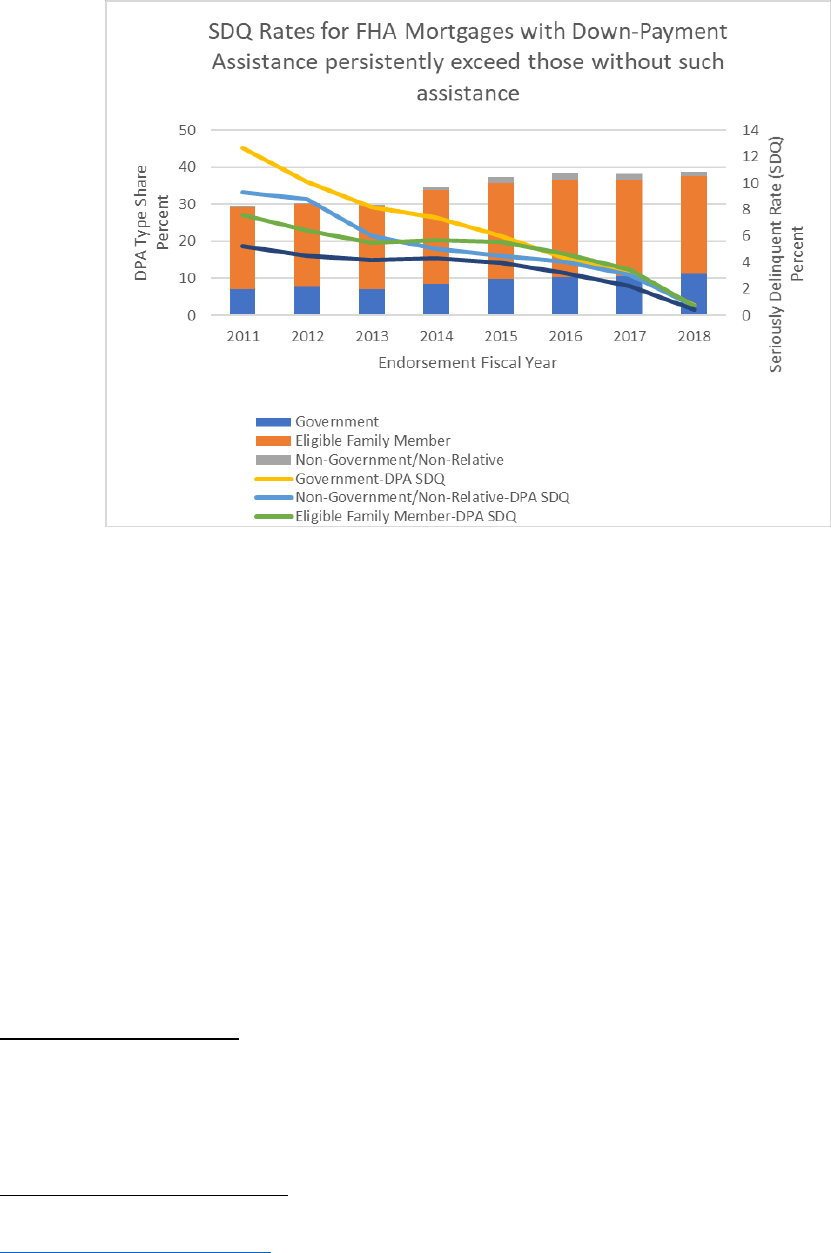
11
Figure 4
FHA must consider reforms that maintain support of high initial LTV mortgages, as well as
alternative options that incent increasing borrower savings dedicated for repayment support in
addition to terms that accelerate equity accumulation, including 20-year mortgages. Faster
accumulation of equity benefits borrowers and provides additional protection to the MMIF in the
event of borrower default. Ultimately, homeownership must prove to be sustainable, which
requires FHA to have the proper incentives in place to ensure a reasonable probability of success
especially in the initial years of the loan when borrowers have accumulated limited equity.
4
In December of 2017, FHA issued a Mortgagee Letter making clear that properties encumbered
with Property Assessed Clean Energy (PACE) obligations will no longer be eligible for an FHA-
insured mortgage. However, FHA remains concerned with PACE assessments that are placed on
FHA loans after endorsement, and is monitoring this practice to determine if further action is
warranted. Taxpayers should never have another lien “jump ahead” of FHA and encumber the
collateral that makes FHA insurance viable and affordable.
Administrative Reforms:
• FHA should implement a Homebuyer Sustainability Scorecard to measure the
performance of loans to low- and moderate-income and FTHBs. The Scorecard will track
the percent of mission borrowers who default, return to renting, refinance out of an FHA
loan, remain in an original FHA-financed home, and monitor the risk associated with
4
American Enterprise Institute, Wealth Building Home Loan, American Enterprise Institute
https://www.aei.org/feature/wbhl/.

12
secondary financing (i.e. DPA). FHA should use the Scorecard to evaluate additional
underwriting criteria to ensure that new lending within its single-family portfolio is
consistent with FHA’s mission.
• FHA should conduct rulemaking to clarify the statutory prohibition on DPA providers
that financially benefit from a transaction.
• FHA should examine incentives to make shorter-term mortgages that accelerate equity
accumulation more attractive to FHA’s mission borrowers.
• FHA should ensure its programs and policies are consistent with its core mission of
serving families who cannot be served by traditional underwriting and that these
programs and policies do not incent negative borrower behavior such as equity stripping
via cash-out refinancing. FHA should continue to monitor its cash-out refinances closely
to determine whether further action is necessary.
• FHA should examine the impact of repeat borrowers on the MMIF and ensure these loans
are consistent with its mission.
Legislative Reforms:
• Congress should establish statutory limitations on FHA cash-out refinances, or at least
ensure alignment (e.g., maximum allowed LTV levels) with such refinance transaction in
the conventional market (manages borrower adverse selection across agencies).
• Congress should authorize the subordination of any state or local authorized PACE liens
that jeopardizes the primary enforcement of FHA’s superior lien for its mortgage
insurance on existing loans.
B. Define Roles for Government-Supported Programs Through Better Coordination
A central principle of the Administration’s reform plan is that federal mortgage credit policies
should be better coordinated in order to allow qualified borrowers to access responsible and
affordable borrowing options and choices. Coordination ensures that there is not unhealthy and
irresponsible competition between government-supported programs, which can lead to lower
underwriting standards, increase risk to taxpayers, and threaten the long-term availability of
credit to qualified borrowers. The GSEs should not be able to selectively choose from the FHA
portfolio and leave taxpayers with the riskiest borrowers.
Due to the fundamental housing missions and mandates of both the GSEs and FHA, borrower
choice in selecting the mortgage product that best fits their needs will result in some overlaps in
the market. As discussed in this plan, the FHA program is primarily utilized by FTHBs who
cannot be served through traditional underwriting, as it generally accepts more risk and provides
low downpayment borrowers greater leverage than allowable in GSE programs while also
offering government-subsidized pricing.

13
Uncoordinated policies create incentives that encourage entities to work at cross-purposes,
resulting in little or no change in overall access to credit while increasing taxpayer exposure to
uncompensated risk. In recent years, the market overlaps might have increased to the extent that
the GSEs expanded credit guidelines to “stretch” into the FHA market. For example, DTIs on
GSE loans expanded significantly in 2018. Efforts are already underway to address these risk
trends and recent new originations indicate progress.
FHFA and FHA should coordinate to ensure that the GSEs and FHA serve defined roles within
the marketplace. Ideally, coordinated policies would bring out the best that each has to offer.
Consistent with their charters, each GSE’s role should be to perform “activities relating to
mortgages on housing for low- and moderate-income families involving a reasonable economic
return that may be less than the return earned on other activities.”
5
Similarly, and consistent with
the Presidential Memorandum, FHA should focus on low- and moderate-income families that
cannot be fulfilled through traditional underwriting.
Administrative Reforms:
• HUD and FHFA should develop and implement a specific understanding as to the
appropriate roles and overlap between the GSEs and FHA, for example, with respect to
the GSEs’ acquisitions of high-LTV and high-DTI loans and FHA’s underwriting of
cash-out refinances, conventional-to-FHA refinances, and loans to FHA repeat
borrowers.
• Critically important to these overlaps is care by FHA that its government-subsidized
premiums, combined with the advantages of the GNMA full faith and credit MBS
guaranty, do not undercut private sector pricing for large segments of mortgage loans that
can be well served by private capital.
Legislative Reforms:
• Congress should establish FHA, VA, and USDA – the government-insured mortgage
loan programs – as the sole source of low downpayment financing for borrowers not
served by the conventional mortgage market.
C. Strengthening FHA Single-Family Default Servicing Processes
A key part of FHA’s modernization effort is to significantly improve FHA’s outdated servicing
policies, processes, and technology. FHA servicing must focus on the critical outcomes of
ensuring sustainable homeownership and protecting taxpayers. Over the past decade, the costs
associated with servicing both performing and non-performing mortgages throughout the
industry have increased significantly. Between 2008 and 2014, the average cost of servicing
performing loans increased from $59 to $158 per loan per year. Over the same period, the
average cost of servicing non-performing loans increased from $482 to $1,949 per loan per year,
peaking at $2,357 in 2013.
6
5
12 U.S.C. § 1716(3).
6
Laurie Goodman, Servicing Is an Underappreciated Constraint on Credit Access, URBAN INSTITUTE (Dec. 15,
2014), https://www.urban.org/research/publication/servicing-underappreciated-constraint-credit-access

14
While servicing costs have increased across the mortgage finance market since the financial
crisis, independent estimates indicate that the FHA’s servicing costs for non-performing loans
are now multiples above the costs of servicing conventional mortgage loans.
7
A recent working
paper by the Federal Reserve Board suggests that the cost of servicing FHA loans in foreclosure
is 50 times the cost of servicing non-delinquent loans, whereas that ratio is 17 for the GSEs.
8
The increase in the cost to service loans within FHA’s mortgage insurance programs has likely
translated into a higher cost of borrowing. FHA proposes the following recommendations to
improve its servicing processes in order to promote sustainable homeownership and protect
taxpayers.
Administrative Reforms:
• To better protect taxpayers, FHA should enhance its ability to better manage borrower
defaults, have more flexibility to work out loans, and make timely changes that will
reduce costs to the MMIF during stressed economic environments.
• FHA should clarify rules around conveyance and enhance consistency on what is
considered “conveyance condition” while incentivizing timely conveyance of properties.
• FHA should enhance its ability to more effectively and efficiently utilize alternatives to
conveyance using a “best execution model” that would reduce cost to the MMIF and
improve outcomes.
• FHA should create more flexible loss mitigation processes, allowing for increased take-
up in such programs, and eliminate unnecessary paperwork and process steps that will
streamline borrower qualification in case of hardship.
• FHA should streamline its default milestone timeline that currently adds to management
costs, providing greater flexibility to servicers and more appropriately incentivizing them
to work toward more efficient resolutions, with consideration given to market conditions.
• FHA should reduce uncertainty and business risk of participation in FHA loan programs
produced by penalties that do not match the severity of missed deadlines.
• FHA should establish a paperless data-driven claims process to replace the current
inefficient and paper-intensive process. The new claims process will ensure that claims
are validated before they are paid in order to better protect taxpayers.
7
Karen Kaul, Laurie Goodman, Alanna McCargo, and Todd M. Hill-Jones, Reforming the FHA’s Foreclosure and
Conveyance Processes, URBAN INSTITUTE (Mar. 1, 2018)
https://www.urban.org/research/publication/reforming-fhas-foreclosure-and-conveyance-processes
8
You Suk Kim, Steven M. Laufer, Karen Pence, Richard Stanton, and Nancy Wallace, Liquidity Crises in the
Mortgage Market, WASHINGTON: BOARD OF GOVERNORS OF THE FEDERAL RESERVE SYSTEM
(2018), https://doi.org/10.17016/FEDS.2018.016r1.
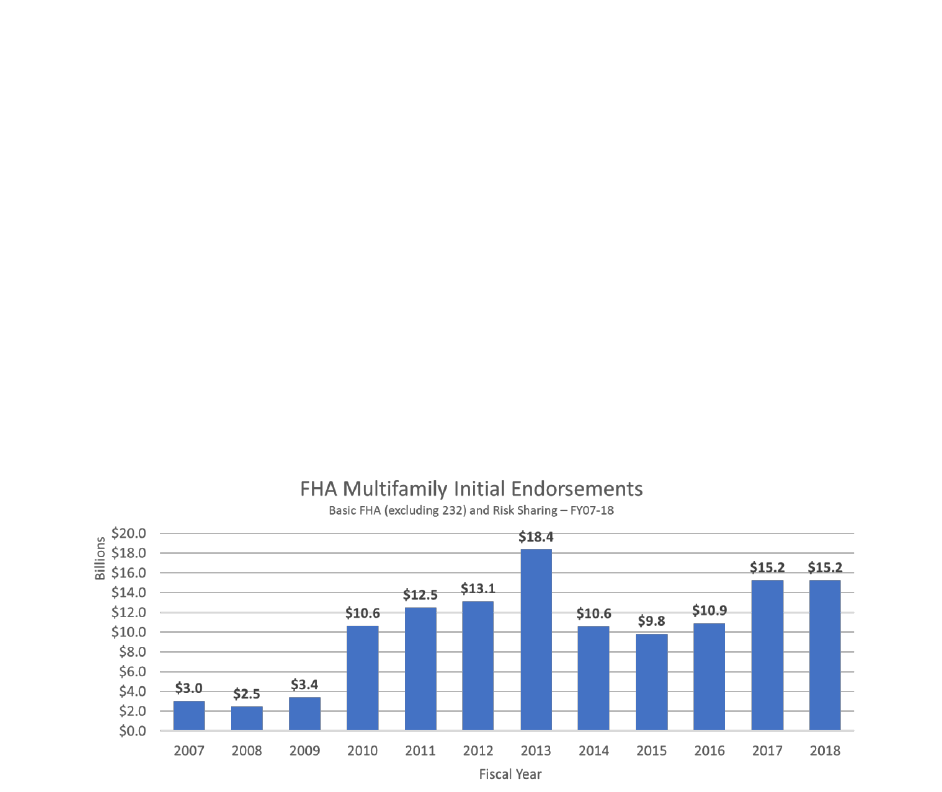
15
• The Consumer Financial Protection Bureau (CFPB), FHA, and FHFA should jointly
study how to reduce the costs of default mortgage servicing.
D. Ensure HUD’s Multifamily Programs are Appropriately Targeted
FHA’s multifamily mortgage insurance products play a critical role in ensuring that credit for
multifamily development is available in many mid-size and smaller markets with a focus on low-
and moderate-income families that are not traditionally served by private sector lenders. By
financing affordable and market-rate housing, FHA’s multifamily program ensures access to safe
and affordable housing for our nation’s workforce and vulnerable populations.
However, FHA’s multifamily lending policies should not discourage private capital from
supporting preservation and development of affordable housing. Over the last decade, FHA’s
multifamily program grew substantially, and its market share remains far above pre-crisis levels.
FHA multifamily production volume peaked in 2013 with $18.4 billion in new originations. In
FY2018, FHA’s multifamily program closed 908 FHA-insured multifamily transactions worth
$15.2 billion with an asset management portfolio composed of 11,549 FHA-insured assets with a
UPB of $97 billion. In addition, FHA manages a portfolio of non-insured assets that support low-
income housing through rental assistance subsidies.
Figure 5
FHA maintains a successful program, the Rental Assistance Demonstration (RAD), allowing
public housing agencies (PHAs) and owners to leverage the private market to make capital
improvements and preserve the properties for long-term affordability. Using one of two
components, RAD facilitates the conversion of properties to project-based Section 8 contracts by
allowing public housing projects to convert to long-term Section 8 rental assistance contracts; or
allowing properties currently operating under HUD’s legacy programs to convert tenant-based
vouchers to project-based assistance. Launched in 2012, it has proven to be a successful model
for preserving HUD-assisted affordable rental housing that might otherwise be lost to disrepair
or neglect.

16
The following administrative and legislative reform recommendations are designed to reduce
barriers to development of affordable rental housing for lower-income, workforce, and
vulnerable populations in the nation’s most underserved markets.
Administrative Reforms:
• Similar to the planned collaboration on single-family housing mortgage insurance
programs, FHA and GNMA should establish proper coordination and information
exchange processes with FHFA to ensure that government-supported multifamily
programs do not overlap and compete with private capital.
• HUD should modify current noise regulations to permit development on property sites
with noise levels above 75 decibels, which would likely encourage development in
walkable, urban areas (including Opportunity Zones) close to transit and jobs and
aligning with FHA’s Multifamily Housing goals of more affordable housing.
• HUD should modify its current environmental review policy to increase the 200-unit
threshold to 300 units which would allow for the completion of multifamily projects in
more reasonable timelines, aligning with HUD’s goals of more affordable rental housing
to better meet the demand.
Legislative Reforms:
• Congress should eliminate the 455,000-unit statutory cap in the RAD program, which
will expand its reach and impact.
• Congress should provide funding for investment in a strategic modernization plan which
will holistically overhaul and integrate FHA’s Multifamily IT systems. These systems
will likely face unsustainable operating and management costs in the near future, and not
leveraging the proposed IT road map, and retaining antiquated IT systems, is likely to
make new future interconnections across HUD difficult, if not impossible.
E. Provide Regulatory Certainty to FHA Lenders
FHA’s lender base has shifted substantially in the last decade. Today, depository institutions
represent less than 15 percent of lenders originating FHA-insured mortgages, down significantly
from approximately 45 percent of the lender base in 2010.
9
Depositories have cited potential
legal liability related to enforcement actions under the FCA as a leading reason for their limited
participation, although increased regulatory burdens after 2010 have contributed to the
decreasing share of depositories in mortgage lending, including participation with FHA.
10
Lenders have expressed concerns with the past discrepancy between the severity of the infraction
and the potential penalties that were sought under the FCA—minor errors leading to exposure to
severe financial penalties.
9
You Suk Kim, Steven M. Laufer, Karen Pence, Richard Stanton, and Nancy Wallace, Liquidity Crises in the
Mortgage Market, BROOKINGS INSTITUTION (2018), https://doi.org/10.17016/FEDS.2018.016r1.
10
Greg Buchak, Gregor Matvos, Tomasz Piskorski, Amit Seru, Fintech, Regulatory Arbitrage, and the Rise of
Shadow Banks, JOURNAL OF FINANCIAL ECONOMICS 130 (3) (2018)
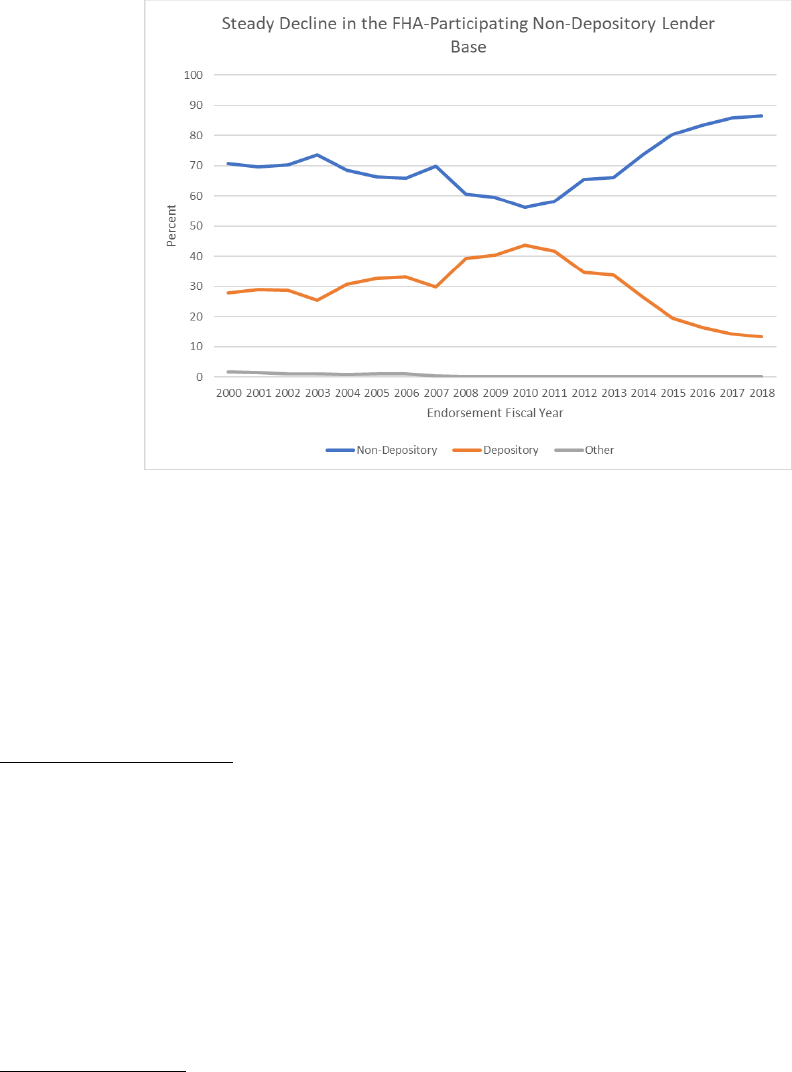
17
Figure 6
FHA strives to be clear in its guidance on compliance and legal enforcement matters and will not
tolerate bad actors—those who seek to defraud borrowers and taxpayers, as well as those who
make routine (and often material) errors that put strain on the agency’s resources. FHA makes it
a top priority to adhere to the rule of law, and this means the agency’s view of materiality should
be clearly communicated. FHA participants and advocacy groups have called for clarification of
the process by which HUD and DOJ consider whether to pursue FCA remedies.
Administrative Reforms:
• FHA should continue to work with the DOJ to provide more clarity on how the agencies
will consult on the appropriate use of the FCA.
• FHA should revise and expand its defect taxonomy in order to clearly align the severity of
loan underwriting defects with proposed remedies.
• FHA should continue prioritizing the revision of certifications, which lenders attest for
each FHA-insured loan, as well as lenders’ annual certifications. These revisions will
provide lenders additional certainty and clarity on FHA’s requirements.
Legislative Reform:
• Congress should make a statutory change to permit shorter suspension periods and
eliminate the annual cap on civil money penalties for program participants to provide FHA
more flexibility when assessing penalties.

18
II. Protect American Taxpayers
A. Strengthen FHA Risk Management Systems and Governance
To ensure protection of the American taxpayer, a modernized FHA risk management
organization is critical. As the size of FHA’s portfolio has not returned to pre-crisis levels and
taxpayers continue to bear increased risk, now is an appropriate time to develop and implement a
framework that will better allow the agency to monitor current, emerging, and future
countercyclical risks. The operational tools to build an exceptional risk management framework
should include establishing appropriate risk tolerances and scorecards to monitor risk, updating
risk model governance, and establishing credit risk transfer (CRT) program(s) which would
introduce private sector investment, reducing risk to the overall FHA portfolio and the American
taxpayer.
The lack of flexibility when addressing egregious underwriting errors or servicing breakdowns
has become particularly detrimental as counterparty risk escalates throughout the mortgage
system. For example, FHA is not allowed to force repurchases – as the GSEs are able – to
enforce underwriting guidelines. FHA instead is limited to an indemnification alternative,
essentially a “promise to pay,” to be applied regardless of the financial wherewithal of the
offending counterparty. An ability to unwind the FHA insurance policy would insulate FHA
from counterparty risk as it enforces its underwriting guidelines. Doing so will reduce the risk
that the taxpayer will have to bear the cost of a counterparty’s failure to perform.
Administrative Reforms:
• FHA should adopt a sound risk-based capital regime for the MMIF, well above the
statutorily mandated two percent capital ratio, which will manage risk exposure to
defined stress scenarios and ensure that FHA does not inappropriately compete with the
GSEs or private capital.
• FHA should adopt a sound risk-based capital standard to manage exposure in the current
insured portfolio for the General Insurance/Special Risk Insurance (GI/SRI) Fund and for
future stress cycles and ensure that FHA does not inappropriately compete with the GSEs
or private capital mortgage financing.
• FHA should pursue an inter-agency agreement with other government agencies
(including GNMA and FHFA) involved in mortgage insurance and mortgage
securitization on counterparty risks.
• FHA should pursue an inter-agency agreement on credit policy coordination with other
government mortgage insurance agencies and FHFA which will help ensure a more
efficient targeting and reducing overlap as FHA (and GNMA) achieve the policy goal of
assuming primary responsibility for providing housing finance support to low- and
moderate-income families that cannot be fulfilled through traditional underwriting.
• FHA should revise its risk-modeling governance, which will include a decreased reliance
on contractors for technical and modeling expertise.

19
Legislative Reforms:
• Congress should direct HUD to evaluate the options, feasibility, and economics of a CRT
program similar to those recently implemented by the GSEs, with the purpose of
exploring options to reduce the overall risk to taxpayers while still serving HUD’s
mission borrowers.
• Congress should direct FHA to more effectively manage lender counterparty risk in
future books by authorizing such additional remedies as appropriate.
B. Improve Financial Viability of the Home Equity Conversion Mortgage Program
At the end of FY2018, FHA’s HECM portfolio had an economic net worth of negative $13.63
billion and a standalone capital ratio of negative 18.83 percent. Changes made to the principal
limit factors and insurance premiums in 2017, as well as the implementation of an appraisal
inflation risk mitigation policy in 2018, have been directionally positive, but financial volatility
within the HECM program remains a challenge for FHA.
The risks in the HECM portfolio have been shaped by the following features:
• HECMs accrue loan balances over time as opposed to forward mortgages where loans
generally amortize as they mature.
• Unique mobility risks generally dependent on the longevity of borrowers (and eligible
non-borrowing spouses that remain in homes secured by HECMs).
11
• HECMs are non-recourse loans, meaning FHA has limited ability to recover financial
losses on loan terminations beyond the value of the property.
12
• HECMs can carry fixed or adjustable rates, although since FY2014, new HECM
endorsements have predominantly been Adjustable Rate Mortgages (ARMs).
• HECMs remain subject to front-end appraisal bias risks and extreme fluctuations in home
valuations. Several analyses have shown the prevalence of appraisal inflation in HECM
transactions—reaching as high as 29 percent in 2009—which ultimately increased losses
to the MMIF.
• Programmatic and capital/fund management challenges dealing with distantly-valued
collateral (based on long-term forecasts of interest rates and home price changes).
• Mortgagee risks in having to fund borrower draws over time with loan balance repayment
only demanded upon termination of HECMs. This puts cash-flow/liquidity risks on
financial institutions originating and servicing HECMs that must fund borrower draws
(that are not always neatly mapped out) prior to receiving any actual repayment from
borrowers.
Administrative Reforms:
• FHA should assess and revise its monitoring protocols of front- and back-end appraisal
bias.
11
Adam W. Shao, Katja Hanewald, Michael Sherris, Reverse Mortgage Pricing and Risk Analysis Allowing for
Idiosyncratic House Price Risk and Longevity Risk, INSURANCE: MATHEMATICS AND ECONOMICS Vol. 63
12
Reverse mortgages, which tend to limit household mobility correlate to discounted property values over time.

20
• FHA should develop servicing standards for HECM products that will result in reduced
operational and financial burdens on servicers and FHA.
• FHA should eliminate HECM-to-HECM refinancing, as these loan transactions result in
greater appraisal inflation, increasing lending against properties that go up in value while
being left with existing portfolio exposure on properties that have minimal (even
decreasing) change in value. These transactions also negatively impact GNMA-
guaranteed HMBS by influencing quick churn in pool participations.
Legislative Reforms:
• Similar to the forward mortgage product, Congress should revise the loan limit structure
in the HECM program to reflect variation in local housing markets and regional
economies across the United States instead of the current national limit set to the level of
high-cost markets in the forward program. Currently, the HECM program utilizes one
nationwide loan limit of $726,525 (for 2019).
• Congress should set a separate HECM capital reserve ratio and remove HECMs as
obligations to the MMIF. This would provide for more transparent accounting of program
costs and decrease cross-subsidization that occurs with mission borrowers in the forward
mortgage portfolio.
C. Implement Tiered Pricing to Protect the MMIF
To ensure that FHA and taxpayers are properly compensated for riskier loans, FHA should
implement a tiered pricing framework to protect the MMIF from excessive exposure to riskier
loans, especially loans with higher risk DPA. Tiered pricing would allow FHA to diminish the
drain of FHA’s higher risk loans on the MMIF. It would not open new markets already served by
private mortgage providers, since FHA would not lower premiums on its 30-year fixed rate
product through this effort.
Administrative Reforms:
• FHA should develop and implement a tiered pricing system in order to protect the MMIF
and ensure it is pricing appropriately for higher-risk loans.
D. Eliminating Regulatory Barriers to Affordable Housing Including Manufactured
Housing
For many American families, ownership of a single-family home represents a key facet of the
American Dream. It is through single-family homeownership that many families put down roots,
become active in their communities, and build wealth for future generations. However,
overregulation of housing construction has been a key factor in supply failing to meet growing
demand, particularly for entry-level housing in high-cost urban markets. As a result, even with
low unemployment and strong wage and job growth, many creditworthy FTHBs are unable to
afford the purchase of entry-level housing.

21
Research indicates that more than 24 percent of the cost of a new single-family home is the
direct result of federal, state, and local regulations.
13
For multifamily, the figure is over 30
percent.
14
This has been a factor in the failure of new multifamily and single-family construction
to keep pace with the formation of new households. Census Bureau data indicates that from 2010
to 2016, only seven homes were built for every ten households formed. This shortage in housing
supply contributes to an unsustainably high financial burden borne by low- and middle-income
Americans.
The Trump Administration is committed to reducing the red tape that is stifling housing choice
for far too many American families. On June 25, the President continued his historic
deregulation campaign by signing an Executive Order establishing the White House Council on
Eliminating Regulatory Barriers to Affordable Housing. The Council, led by HUD Secretary Ben
Carson, will build on the President’s commitment to hardworking Americans by reducing overly
burdensome regulations that artificially raise the cost of housing development that directly lead
to the undersupply of affordable housing, and engaging with state, local, and tribal partners to
help them do the same.
For many American families, entry-level housing options, including starter homes,
condominiums and manufactured housing, serve as important steppingstones to achieving their
ultimate dream of purchasing a single-family home in which to raise their children and build
wealth for the long term. HUD plays a critical role in helping creditworthy first-time and low-
and moderate-income borrowers achieve their goals, through FHA’s insurance of entry-level
housing, from which borrowers can successfully graduate to non-government-supported
mortgages of future homes.
Manufactured housing
15
plays a vital role in meeting the nation’s affordable housing needs,
providing 9.5 percent of the total single-family housing stock. More than 22 million Americans
reside in manufactured housing with a median annual household income of less than $30,000.
Manufactured homes are particularly important in rural communities, where they are
approximately 16.2 percent of occupied housing units. The manufactured housing industry also
plays an important part in the economy, accounting for approximately 40,000 jobs nationwide.
16
HUD regulation of manufactured housing fulfills a critical role of both protecting consumers and
ensuring a fair and efficient market.
Policies that exclude or disincentivize the utilization of manufactured homes can exacerbate
housing affordability challenges because manufactured housing potentially offers a more
13
Paul Emrath, Ph.D., Government Regulation in the Price of a New Home, HOUSINGECONOMICS.COM (May
2, 2016), http://www.nahbclassic.org/generic.aspx?genericContentID=250611&channelID=311
14
Paul Emrath and Caitlin Walter, Regulation: Over 30 Percent of the Cost of a Multifamily Development,
NATIONAL ASSOCIATION OF HOME BUILDERS (June 12, 2018),
http://www.nahbclassic.org/generic.aspx?genericContentID=262391
15
A manufactured home is built to the Manufactured Home Construction and Safety Standards (HUD Code) and
displays a red certification label on the exterior of each transportable section. Manufactured homes are built in the
controlled environment of a manufacturing plant and are transported in one or more sections on a permanent chassis.
16
Manufactured Housing Institute, 2018 Manufactured Housing Facts: Industry Overview, MANUFACTURED
HOUSING INSTITUTE (June 2018), https://www.manufacturedhousing.org/wp-content/uploads/2018/06/2018-
MHI-Quick-Facts-updated-6-2018.pdf

22
affordable alternative to traditional site-built housing without compromising building safety and
quality. The failure to periodically update the Construction and Safety Standards, for example,
has hindered the manufactured housing industry’s ability to economize and leverage current
construction techniques and materials that require special HUD approvals. In the previous
Administration, updating the Construction and Safety Standards was not a priority, and the
current requirements have not been updated in any significant way since 2009. HUD should take
action to address barriers to the greater adoption of manufactured housing.
Administrative Reforms:
• Pursuant to the Executive Order of June 25, 2019, the HUD-led White House Council on
Eliminating Regulatory Barriers to Affordable Housing will identify and recommend
actions and policies to mitigate regulations that unnecessarily increase the cost of creating
and preserving housing that is affordable and work with state, local, and tribal partners to
do the same.
• FHA should consider innovative proposals to modify single-family housing mortgage
finance underwriting to further encourage and promote additional supply of entry-level
housing, particularly manufactured housing.
• To encourage innovation in manufactured housing, HUD should create a formal
framework for identifying and evaluating new building, construction, and design
developments and ensuring that HUD’s regulations do not unnecessarily impede their
adoption. This framework would help gather the evidence necessary to update HUD’s
regulations on a regular cadence, thereby better keeping up with evolving technology.
• HUD should devote resources to ensure the HUD-Code is modernized to incorporate the
standards recommended by the MHCC, to minimize overly burdensome regulatory and
compliance requirements, and to encourage innovation. Once revised, HUD should also
move to a regular cadence of updating its code to ensure that it is keeping pace with
evolving technologies and best practices.
• HUD should publish updated Title I standards that address regulatory burdens of
participating in the program as part of its Single Family Housing Policy
Handbook 4000.1 (SF Handbook), which is intended to serve as the consolidated,
consistent, and comprehensive source of FHA Single Family Housing policy.
• HUD should elevate the Office of Manufactured Housing Programs within HUD and
appoint a Deputy Assistant Secretary to lead it.

23
III. Provide FHA and GNMA the Tools to Appropriately Manage
Risk
A. Establish FHA as an Autonomous Corporation within HUD
FHA was established as an independent agency in 1934, but was incorporated into HUD when
the Department was created in 1965. Unlike other offices within HUD, which generally support
very low- and extremely low-income individuals and families, FHA offers mortgage insurance
products to enhance access to homeownership, rental housing, and healthcare facilities. FHA
needs autonomy within HUD to ensure it is able to keep pace with evolving portfolios and a
dynamic, ever-changing marketplace. More independence would provide FHA greater control
over staffing and procurement, including technology. It is vital that FHA be given increased
authority to better address risk management functions that can suffer from being part of a larger
organization.
Legislative Reform:
• Congress should enact legislation to restructure FHA as an autonomous government
corporation within HUD.
B. Hire and Retain the Right Talent to Mitigate Risks to Taxpayers
FHA and GNMA face challenges in hiring and retaining sufficient staff with expertise in
mortgage finance and asset management. FHA and GNMA need the appropriate staff to manage
their current large portfolios and ensure future books of business are appropriately mission-
focused. Despite a significant increase in volume in both the forward and reverse mortgage
programs, FHA’s Office of Single Family Housing staff has decreased from 1,007 full-time
employees (FTEs) in 2010 to 751 FTEs as of August 2019, a decline of 25 percent. Furthermore,
28.7 percent of the current workforce is eligible for retirement and 45.76 percent will be eligible
within 5 years. By addressing these human capital challenges, FHA and GNMA can improve the
management and oversight of their guaranteed loan and MBS portfolios.
Administrative Reforms:
• Like GNMA, FHA should explore the targeted use of pay flexibilities available under
current law (e.g., Critical Pay) to improve hiring and retention of key positions requiring
specialized technical skills related to the mortgage and securitization markets.
C. Align Contracting and Procurement Processes with Business Needs
FHA is limited in its ability to engage qualified and capable contractors in a timely manner
because HUD’s contracting process is burdensome and protracted. The material deficiencies in
the agency’s operational processes, risk management guidelines, and technologies have
contributed to losses to the MMIF and a failure to capably protect HUD’s security interests,
respond to customer and borrower inquiries, monitor loans for program compliance, and process
property disposition requests. GNMA has made broad use of its authority as a government
corporation to contract for services as it conducts commercial activities. Its ability to do this

24
effectively has been a major contributor to its record of achieving its mission on a large scale
with a notably smaller base of government staff.
Legislative Reform:
• To the extent administrative reforms are insufficient to address procurement challenges at
FHA and GNMA, Congress should propose new statutory acquisition authorities for
HUD, particularly to address instances where material underperformance of contracting
vendors results in substantial quality deficiencies and costs.
D. Modernize FHA Technology
FHA has operated for decades on antiquated technology platforms that inhibit its ability to
appropriately manage risk. FHA’s over-reliance on outdated IT platforms ultimately increases
the cost of mortgage credit by increasing business operating costs of originators and loan
servicers. Currently, FHA’s platform is built on a more than 40-year-old mainframe system that
runs an obsolete programming language. The risk that this presents to FHA and, by extension, to
the American taxpayer, is significant. Not only is FHA’s current IT system outdated—it is
unreliable. In FY2018 alone, there were 174 outages of Single Family’s core systems.
To support the broad goal of greater standardization between FHA and industry business
practices and processes, FHA has developed a detailed technology roadmap that will guide the
development of a single platform and baseline architecture. The new IT system will cover all
aspects of the mortgage process, from loan origination, through endorsement, servicing, claims,
and, as required, disposition.
The investment in the new single platform structure will allow FHA to better adapt to changing
industry, regulatory, and statutory requirements. The modernized systems will be data-driven,
and ultimately allow FHA to fully digitize the mortgage process, opening doors to significantly
more intensified risk analysis and management. The completion of this effort will permit FHA to
increase compliance and reduce costly operational burdens, such as heavily paper-based
processes currently in place. Importantly, it will also protect taxpayers from losses that result
from fraud, in addition to reducing costs associated with maintaining and operating inefficient
legacy systems and business processes.
By grounding the development of the new architecture in reducing operational risk, FHA can
focus on delivering much-needed clarity and efficiency in its programs. This approach also lays
the foundation for the incremental phase-out of FHA’s legacy mainframe systems. By
modernizing now, FHA has an opportunity to move generations ahead to a state-of-the-art
system that leverages industry advancements including fast-feedback mortgage applications,
upfront certainty, appraisal scoring, revised Mortgage Industry Standards Maintenance
Organization (MISMO) data standards, integration of independent verification services, an
application programming interface (API) driven ecosystem, and active loss mitigation guidance.
Administrative Reforms:
• FHA should explore agreements to share technology with GNMA and other government-
supported mortgage programs when feasible.

25
• FHA should develop a mortgage origination risk tool integrating an automated
underwriting system (AUS) platform, appraisal scorecard, risk assessment tool, and third-
party verification services.
Legislative Reforms:
• Congress should appropriate sufficient funds for FHA to complete its multi-year single-
family IT modernization effort.
E. Realign Housing Assistance Programs into a New Office of Rental Subsidy and Asset
Oversight within HUD
The Federal Housing Commissioner oversees and administers mortgage insurance on FHA’s
single-family forward and reverse, multifamily, and healthcare programs. Concurrently, that
same person serves as the Assistant Secretary for Housing, overseeing and administering
programs that provide rental assistance and subsidy to low-income, very low-income, and
extremely low-income Americans including: Project-Based Rental Assistance (PBRA), Section
202 Housing for the Elderly, Section 811 Housing for the Disabled; the Rental Assistance
Demonstration (RAD) program; federal regulation of manufactured housing, and housing
counseling.
As it considers restructuring FHA as an autonomous corporation within HUD, Congress also
should consolidate the PBRA, Public Housing, and Housing Choice Voucher subsidy programs
(Sections 8 and 9), along with the RAD and Real Estate Assessment Center (REAC) functions,
into a newly created Office of Rental Subsidy and Asset Oversight within HUD. In doing so,
Congress should separate the dual roles of Federal Housing Commissioner and Assistant
Secretary for Housing, as the Federal Housing Commissioner’s duties should focus solely on
managing the FHA insurance programs. The realignment will achieve greater efficiencies,
reduce regulatory and administrative burdens, increase self-sufficiency opportunities for
residents receiving federal rental assistance or supportive services, and promote greater cost
efficiency and asset management of the subsidized portfolio.
Administrative Reform:
• Absent legislation, the Department should pursue a reorganization that separates its
mortgage insurance and rental assistance programs into separate offices.
Legislative Reforms:
• Congress should enact legislation to separate the position and responsibilities of the
Federal Housing Commissioner from the position and responsibilities of the Assistant
Secretary for Housing.
• Congress should enact legislation to create a new Office of Rental Subsidy and Asset
Oversight overseen by the Assistant Secretary for Housing which would consolidate
multifamily housing subsidy programs, Public Housing and Housing Choice Voucher
programs, together with RAD and REAC.
26
• As part of this reorganization, Congress should establish the Office of Native American
Programs as a separate office, led by a Presidentially-appointed, Senate-confirmed
Assistant Secretary and separate the Native American programs from the other programs
within HUD’s Office of Public and Indian Housing.

27
IV. Provide Liquidity to the Housing Finance System
Issuers participating in GNMA’s MBS guaranty program pay the agency an on-going guaranty
fee, as well as other incidental fees, predominantly for provision of the guaranty on pass-through
income to securities investors. The guaranty fees charged by GNMA are fixed and set in statute.
Interest income from borrowers in excess of the pass-through rate payable to security holders and
GNMA’s guaranty fee is retained by the issuer as mortgage servicing fees. GNMA’s program
requires the retention of certain minimum servicing fees to ensure servicing of the loans for the
life of the GNMA MBS guaranty. Servicing fees, along with other cash flows associated with the
on-going servicing of the mortgage loan (and net of the costs to service the mortgage loan),
constitute an asset of the issuer called mortgage servicing rights (MSRs).
GNMA has prioritized risk management and the ongoing need for programmatic and
organizational change to reduce the risk of issuer failures, thus minimizing the possibility of
utilizing taxpayer funds in the operationalizing of the GNMA guaranty. In this regard, the agency
faces a wide spectrum of risks stemming from the risk of a single large issuer failure (today, for
example, nearly 40 percent of the securities outstanding are serviced by five non-banks) to
multiple issuer failures, which would be operationally challenging to manage simultaneously (at
present, one percent of the securities outstanding are serviced by 125 non-bank issuers).
Overall, there are five key areas where GNMA will continue to focus its efforts and implement
reforms:
• Strengthening the internal framework and operational structure to best manage
counterparty risk by re-aligning internal responsibilities and creating new position and
processes to monitor and address sources of risk that have increased as the housing
financing industry has evolved.
• Increasing reliance on data and modeling to uncover and illuminate trends and risks that
are not apparent from traditional compliance activities – a prime example is leading the
industry toward widespread use of stress testing modeling.
• Increasing the enforcement, recovery and resolution capabilities in the event of issuer
stress, with the objective that GNMA would be address adverse circumstances, including
a large-scale issuer failure, without the occurrence of severe market or consumer
disruption.
• Continuing focus on facilitating sufficient system liquidity (and liquidity management
practices), given the now non-bank-dominated industry’s increased reliance on steady
flows of external capital.
• Continuing refinement of program standards and requirements relating to all of the
above.

28
A. Advance GNMA Counterparty Risk Management and Securitization Platform
Transformation
GNMA should increase its counterparty risk management ability. GNMA continues to rely on
existing staff resources, the ability to update policies and requirements through All Participants
Memorandums (APMs), and the authority to take enforcement action if required. Critical to
GNMA’s success in such reform is support and coordination with those that oversee GNMA,
such as HUD and OMB.
The following details the areas where GNMA should continue to strengthen and modernize its
internal approach to risk, program guidelines and securitization platform transformation to better
serve and protect borrowers, investors, issuers and taxpayers.
Administrative Reforms:
• GNMA should transition the MBS platform from pool-level to loan-level functionality,
including the ability to transfer servicing of individual loans within a pool. This reform will
enhance the desirability and value of the MSR asset and reduce the cost of loans insured or
guaranteed by Federal agencies relative to conventional loans.
• GNMA should continue to facilitate adequate liquidity in the housing finance system,
including the implementation of reforms for the financing of and investment in MSRs, and
oversight of the development of industry-level liquidity management methods, as outlined in
the GNMA 2020 reform agenda.
17
• GNMA should continue to maximize the value of its servicing portfolios, such as through
establishing servicing fee standards and enhanced monitoring of servicing transfers to ensure
that both parties maintain adequate MSR values.
• GNMA should enhance issuer standards through strengthened risk management
requirements, including updated liquidity, leverage, and capital standards, with particular
focus on very large issuers and sub-servicers.
• GNMA should strengthen its risk management analytics and predictive capabilities to
mitigate risks, given the growing share of the agency’s portfolio comprised of very large,
non-bank counterparties. This should include GNMAs ongoing development of stress test
modeling capability and the imposition of a stress testing regimen for non-bank institutions
to evaluate performance under a range of economic scenarios.
• GNMA should implement enforcement, recovery and resolution reforms to protect taxpayers,
which should include building the capability for the agency to move quickly, effectively and
fairly to sanction firms who are failing to abide by program terms, and to address issuers who
are vulnerable to failure, or otherwise threatens the sound administration of the MBS
program.
17
https://www.ginniemae.gov/newsroom/publications/Documents/ginniemae_2020_progress_update.pdf

29
• GNMA should fully modernize platform access, data standards, collection, and storage,
which will transform the user interaction with the securitization and data analytical
architecture into a highly secure, single gateway. This reform would increase GNMA’s
ability to monitor its issuers, enforce its rules and requirements, and manage the overall
safety and soundness of the program, as well as efficacy and validity of data collected and
reported through the Mortgage Banker’s Financial Reporting Form.
• GNMA should develop and implement the policies, technology and operational capabilities
necessary to accept digital promissory notes (eNotes) and other digitized loan files as
acceptable collateral for its securities, which will enable issuers to enhance efficiency, risk
management and customer experience by moving to digital collateral and a fully electronic
“eClosing” process.
B. Guaranty Fee-setting Flexibility
GNMA’s single-family guaranty fee of six basis points (bps) was set by statute 1987. This
guaranty fee provides the funds from which losses would be paid if GNMA needed to step in to
remit funds to security-holders as the result of an issuer’s failure to do so. This six bps guaranty
fee is also the source of funds for payments relating to loans that were in pools seized in the past
by GNMA in cases of issuer failure.
GNMA believes that the authority to administratively adjust its guaranty fee within a narrow,
permissible range, would ensure that such fees are adequate for the risks in the program and
sufficient for GNMA to meets its statutory obligations under extreme circumstances. Under this
proposal, GNMA would be required to justify and seek approval for any proposed adjustments
from the HUD Secretary, but the change would require no further passage of law.
GNMA currently possesses a level of reserves the agency deems adequate to meet foreseeable
needs to exercise and fulfill its guaranty. Thus, GNMA is not at this time proposing a specific
increase in the fee. GNMA’s financial requirements have increased, however, and are likely to
continue to do so, notably due to the increasing share of non-bank responsibility for residential
mortgage servicing which has increased both the likelihood and the potential size of a call on
GNMA’s guaranty. This reform recommendation is not be intended to change the purpose of the
guaranty fee, which is to provide funds for financial obligations resulting from GNMA having
exercised the guaranty. Rather, the reform would provide flexibility to the agency to seek
adjustments needed to ensure efficiency and operational effectiveness as the secondary mortgage
market continues to evolve, and ultimately ensure its MBS guaranty program maintains fiscal
soundness.
18
18
For reference, this item was highlighted in Government Accountability Office’s (GAO) May 2019 audit, “GNMA:
Risk Management and Staffing-Related Challenges Need to be Addressed.” Specifically, GAO recommended that
“The Chief Risk Officer of GNMA should periodically conduct an actuarial or similar analysis that includes a stress
test to evaluate the extent to which the current level of the guaranty fee for single-family MBS provides GNMA with
sufficient reserves to cover potential losses under different economic scenarios.”

30
Legislative Reform:
• Congress should pass legislation granting GNMA the authority to administratively adjust
its guaranty fee within a narrow, permissible range.
C. Reforms to Maintain the Integrity of GNMA Securities
Over the past two years, GNMA has identified unsound loan origination and servicing practices,
broadly referenced as churning, that has elevated risks to the integrity of the MBS security as
investors attempt to account for such prepayment risks. This churning can increase the cost of
mortgage credit for borrowers utilizing FHA, USDA, and VA mortgage insurance.
Starting in 2016, GNMA instituted a six-month “seasoning” requirement for VA streamline
loans, and then in 2017 the agency extended the requirement to include cash-out refinances.
Additionally, in May 2018, federal legislation was enacted that placed additional requirements
for VA streamline loans and, in accordance with the law, the VA published a final rule placing
certain requirements for cash-out refinances, which have ultimately helped to protect Veteran
borrowers as well as restore confidence in the GNMA MBS among the agency’s investor base.
To date, nonetheless, prepayment speeds in the GNMA security continue to remain elevated
relative to historic norms and current interest rates. Therefore, GNMA is continuing its efforts to
reduce loan churning in all programs.
Administrative Reforms:
• GNMA should continue to coordinate with appropriate federal mortgage insurance
programs, take action where (and when) necessary to the integrity of the GNMA MBS
guaranty, and advance efforts to provide further data transparency to address higher-than-
necessary note rate mortgages.
• GNMA should work with other federal parties to implement sound “Net Tangible
Benefit” tests by all federal mortgage insurance programs.

31
Conclusion
FHA and GNMA play a critical role in the nation’s housing finance system and any fundamental
reforms must account for this. Better coordination among certain institutions – principally FHA,
GNMA, and FHFA – is important to ensure that government-supported programs are not
crowding out private capital, and instead focus on policies that serve borrowers, including
potential first-time and low- and moderate-income homebuyers, that may not have access to
appropriate mortgage credit through traditional underwriting without government support.
FHA and GNMA should focus on helping these borrowers become sustainable homeowners
while minimizing risk to the taxpayer to the greatest extent possible and providing a path for
borrowers to graduate from government-supported programs. For too long FHA and GNMA
have operated somewhat isolated from the rest of the housing finance system – often without the
proper resources, technology, and authority to fulfill their responsibilities to borrowers, industry
partners, and the American taxpayers. The Presidential Memorandum provides an opportunity
for this Administration to ensure FHA and GNMA can continue to serve their important missions
effectively, responsibly, and sustainably.

I
Appendix A
Legislative and Administrative Recommendations
Recommendation
Type
Timeline
I. Refocus FHA to its Core Mission
A. Targeting Programs to Borrowers Not Served by Traditional Underwriting
1.
FHA should implement a Homebuyer Sustainability
Scorecard to measure the performance of loans to low- and
moderate-income and FTHBs. The Scorecard will track the
percent of mission borrowers who default, return to renting,
refinance out of an FHA loan, remain in an original FHA-
financed home, and monitor the risk associated with
secondary financing (i.e. DPA). FHA should use the
Scorecard to evaluate additional underwriting criteria to
ensure that new lending within its single-family portfolio is
consistent with FHA’s mission.
Administrative
As promptly
as practicable
2.
FHA should conduct rulemaking to clarify the statutory
prohibition on DPA providers that financially benefit from
a transaction.
Administrative
As promptly
as practicable
3.
FHA should examine incentives to make shorter-term
mortgages that accelerate equity accumulation more
attractive to FHA’s mission borrowers.
Administrative
As promptly
as practicable
4.
FHA should ensure its programs and policies are consistent
with its core mission of serving families who cannot be
served by traditional underwriting and that these programs
and policies do not incent negative borrower behavior such
as equity stripping via cash-out refinancing. FHA should
continue to monitor its cash-out refinances closely to
determine whether further action is necessary.
Administrative
N/A
5.
FHA should examine the impact of repeat borrowers on the
MMIF and ensure these loans are consistent with its
mission.
Administrative
As promptly
as practicable
6.
Congress should establish statutory limitations on FHA
cash-out refinances, or at least ensure alignment (e.g.,
maximum allowed LTV levels) with such refinance
transaction in the conventional market (manages borrower
adverse selection across agencies).
Legislative
N/A
7.
Congress should authorize the subordination of any state or
local authorized PACE liens that jeopardizes the primary
enforcement of FHA’s superior lien for its mortgage
insurance on existing loans.
Legislative
N/A

II
Recommendation
Type
Timeline
B. Define Roles for Government-Supported Programs Through Better Coordination
8.
HUD and FHFA should develop and implement a specific
understanding as to the appropriate roles and overlap
between the GSEs and FHA, for example with respect to
the GSEs’ acquisitions of high-LTV and high-DTI loans
and FHA’s underwriting of cash-out refinances,
conventional-to-FHA refinances, and loans to FHA repeat
borrowers.
Administrative
As promptly
as practicable
9.
Critically important to these overlaps is care by FHA that
its government-subsidized premiums, combined with the
advantages of the GNMA full faith and credit MBS
guaranty, do not undercut private sector pricing for large
segments of mortgage loans that can be well served by
private capital.
Administrative
As promptly
as practicable
10.
Congress should establish FHA, VA, and USDA – the
government-insured mortgage loan programs – as the sole
source of low downpayment financing for borrowers not
served by the conventional mortgage market.
Legislative
N/A
C. Strengthening FHA Single-Family Default Servicing Processes
11.
To better protect taxpayers, FHA should enhance its ability
to better manage borrower defaults, have more flexibility to
work out loans, and make timely changes that will reduce
costs to the MMIF during stressed economic environments.
Administrative
As promptly
as practicable
12.
FHA should clarify rules around conveyance and enhance
consistency on what is considered “conveyance condition”
while incentivizing timely conveyance of properties.
Administrative
As promptly
as practicable
13.
FHA should enhance its ability to more effectively and
efficiently utilize alternatives to conveyance using a “best
execution model” that would reduce cost to the MMIF and
improve outcomes.
Administrative
As promptly
as practicable
14.
FHA should create more flexible loss mitigation processes,
allowing for increased take-up in such programs and
eliminate unnecessary paperwork and process steps that
will streamline borrower qualification in case of hardship.
Administrative
As promptly
as practicable
15.
FHA should streamline its default milestone timeline that
currently adds to management costs, providing greater
flexibility to servicers and more appropriately incentivizing
them to work toward more efficient resolutions, with
consideration given to market conditions.
Administrative
As promptly
as practicable

III
Recommendation
Type
Timeline
16.
FHA should reduce uncertainty and business risk of
participation in FHA loan programs produced by penalties
that do not match the severity of missed deadlines.
Administrative
As promptly
as practicable
17.
FHA should establish a paperless data-driven claims
process to replace the current inefficient and paper-
intensive process. The new claims process will ensure that
claims are validated before they are paid in order to better
protect taxpayers.
Administrative
As promptly
as practicable
18.
The CFPB, FHA, and FHFA should jointly study how to
reduce the costs of default mortgage servicing.
Administrative
As promptly
as practicable
D. Ensure HUD’s Multifamily Programs are Appropriately Targeted
19.
Similar to the planned collaboration on single-family
housing mortgage insurance programs, FHA and GNMA
should establish proper coordination and information
exchange processes with FHFA to ensure that government-
supported multifamily programs do not overlap and
compete with private capital.
Administrative
As promptly
as practicable
20.
HUD should modify current noise regulations to permit
development on property sites with noise levels above 75
decibels, which would likely encourage development in
walkable, urban areas (including Opportunity Zones) close
to transit and jobs and aligning with FHA’s Multifamily
Housing goals of more affordable housing.
Administrative
As promptly
as practicable
21.
HUD should modify its current environmental review
policy to increase the 200-unit threshold to 300 units which
would allow for the completion of multifamily projects in
more reasonable timelines, aligning with HUD’s goals of
more affordable rental housing to better meet the demand.
Administrative
As promptly
as practicable
22.
Congress should eliminate the 455,000-unit statutory cap in
the RAD program, which will expand its reach and impact.
Legislative
N/A
23.
Congress should provide funding for investment in a
strategic modernization plan which will holistically
overhaul and integrate FHA’s Multifamily IT systems.
These systems will likely face unsustainable operating and
management costs in the near future, and not leveraging the
proposed IT road map, and retaining antiquated IT systems,
is likely to make new future interconnections across HUD
difficult, if not impossible.
Legislative
N/A
E. Provide Regulatory Certainty to FHA Lenders

IV
Recommendation
Type
Timeline
24.
FHA should continue to work with the DOJ to provide
more clarity on how the agencies will consult on the
appropriate use of the FCA.
Administrative
As promptly
as practicable
25.
FHA should revise and expand its defect taxonomy in order
clearly align the severity of loan underwriting defects with
proposed remedies.
Administrative
As promptly
as practicable
26.
FHA should continue prioritizing the revision of
certifications which lenders attest for each FHA-insured
loan as well as lenders’ annual certifications. These
revisions will provide lenders additional certainty and
clarity on FHA’s requirements.
Administrative
As promptly
as practicable
27.
Congress should make a statutory change to permit shorter
suspension periods and eliminate the annual cap on civil
money penalties for program participants to provide FHA
more flexibility when assessing penalties.
Legislative
N/A
II.
Protect American Taxpayers
A. Strengthen FHA Risk Management Systems and Governance
28.
FHA should adopt a sound risk-based capital regime for the
MMIF, well above the statutorily mandated two percent
capital ratio, which will manage risk exposure to defined
stress scenarios and ensure that FHA does not
inappropriately compete with the GSEs or private capital.
Administrative
As promptly
as practicable
29.
FHA should adopt a sound risk-based capital standard to
manage exposure in the current insured portfolio for the
GI/SRI Fund and for future stress cycles and ensure that
FHA does not inappropriately compete with the GSEs or
private capital mortgage financing.
Administrative
As promptly
as practicable
30.
FHA should pursue an inter-agency agreement with other
government agencies (including GNMA and FHFA)
involved in mortgage insurance and mortgage securitization
on counterparty risks.
Administrative
As promptly
as practicable
31.
FHA should pursue an inter-agency agreement on credit
policy coordination with other government mortgage
insurance agencies and FHFA which will help ensure a
more efficient targeting and reducing overlap as FHA (and
GNMA) achieve the policy goal of assuming primary
responsibility for providing housing finance support to low-
and moderate-income families that cannot be fulfilled
through traditional underwriting.
Administrative
As promptly
as practicable

V
Recommendation
Type
Timeline
32.
FHA should revise its risk-modeling governance, which
will include a decreased reliance on contractors for
technical and modeling expertise.
Administrative
As promptly
as practicable
33.
Congress should direct HUD to evaluate the options,
feasibility, and economics of a CRT program(s) similar to
those recently implemented by the GSEs with the purpose
of exploring options to reduce the overall risk to taxpayers
while still serving HUD’s mission and homeownership
objectives.
Legislative
N/A
34.
Congress should direct FHA to more effectively manage
lender counterparty risk in future books by authorizing such
additional remedies as appropriate.
Legislative
N/A
B. Improve Financial Viability of the Home Equity Conversion Mortgage Program
35.
FHA should assess and revise its monitoring protocols of
front- and back-end appraisal bias.
Administrative
As promptly
as practicable
36.
FHA should develop servicing standards for HECM
products that will result in reduced operational and
financial burdens on servicers and FHA.
Administrative
As promptly
as practicable
37.
FHA should eliminate HECM-to-HECM refinancing, as
these loan transactions result in greater appraisal inflation,
increasing lending against properties that go up in value
while being left with existing portfolio exposure on
properties that have minimal (even decreasing) change in
value. These transactions also negatively impact GNMA-
guaranteed HMBS by influencing quick churn in pool
participations.
Administrative
As promptly
as practicable
38.
Similar to the forward mortgage product, Congress should
revise the loan limit structure in the HECM program to
reflect variation in local housing markets and regional
economies across the United States instead of the current
national limit set to the level of high-cost markets in the
forward program. Currently, the HECM program utilizes
one nationwide loan limit of $726,525 (for 2019).
Legislative
N/A
39.
Congress should set a separate HECM capital reserve ratio
and remove HECMs as obligations to the MMIF. This
would provide for more transparent accounting of program
costs and decrease cross-subsidization that occurs with
mission borrowers in the forward mortgage portfolio.
Legislative
N/A
C. Implement Tiered Pricing to Protect the MMIF

VI
Recommendation
Type
Timeline
40.
FHA should develop and implement a tiered pricing system
in order to protect the MMIF and ensure it is pricing
appropriately for higher-risk loans.
Administrative
As promptly
as practicable
D. Eliminating Regulatory Barriers to Affordable Housing Including Manufactured Housing
41.
Pursuant to the Executive Order of June 25, 2019, the
HUD-led White House Council on Eliminating Regulatory
Barriers to Affordable Housing will identify and
recommend actions and policies to mitigate regulations that
unnecessarily increase the cost of creating and preserving
housing that is affordable and work with state, local, and
tribal partners to do the same.
Administrative
As promptly
as practicable
42.
To encourage innovation, in manufactured housing, HUD
should create a formal framework for identifying and
evaluating new building, construction, and design
developments and ensuring that HUD’s regulations do not
unnecessarily impede their adoption. This framework
would help gather the evidence necessary to update HUD’s
regulations on a regular cadence, thereby better keeping up
with evolving technology.
Administrative
As promptly
as practicable
43.
FHA should consider innovative proposals to modify
single-family housing mortgage finance underwriting to
further encourage and promote additional supply of entry-
level housing, particularly manufactured housing.
Administrative
As promptly
as practicable
44.
HUD should devote resources to ensure the HUD-Code is
modernized to incorporate the standards recommended by
the MHCC, to minimize overly burdensome regulatory and
compliance requirements, and to encourage innovation.
Once revised, HUD should also move to a regular cadence
of updating its code to ensure that it is keeping pace with
evolving technologies and best practices.
Administrative
As promptly
as practicable
45.
HUD should publish updated Title I standards that address
regulatory burdens of participating in the program as part of
its Single Family Housing Policy Handbook 4000.1 (SF
Handbook), which is intended to serve as the consolidated,
consistent, and comprehensive source of FHA Single
Family Housing policy.
Administrative
As promptly
as practicable
46.
HUD should elevate the Office of Manufactured and
Innovative Housing Programs within HUD and appoint a
Deputy Assistant Secretary to lead it.
Administrative
As promptly
as practicable

VII
Recommendation
Type
Timeline
III. Provide FHA and GNMA the Tools to Appropriately Manage Risk
A. Establish FHA as an Autonomous Corporation within HUD
47.
Congress should enact legislation to restructure FHA as an
autonomous government corporation within HUD.
Legislative
N/A
B. Hire and Retain the Right Talent to Mitigate Risks to Taxpayers
48.
Like GNMA, FHA should explore the targeted use of pay
flexibilities available under current law (e.g., Critical Pay)
to improve hiring and retention of key positions requiring
specialized technical skills related to the mortgage and
securitization markets.
Administrative
As promptly
as practicable
C. Align Contracting and Procurement Processes with Business Needs
49.
To the extent administrative reforms are insufficient to
address procurement challenges at FHA and GNMA,
Congress should propose new statutory acquisition
authorities for HUD, particularly to address instances where
material underperformance of contracting vendors results in
substantial quality deficiencies and costs.
Legislative
N/A
D. Modernize FHA Technology
50.
FHA should explore agreements to share technology with
GNMA and other government-supported mortgage
programs when feasible.
Administrative
As promptly
as practicable
51.
FHA should develop a mortgage origination risk tool
integrating an automated underwriting system (AUS)
platform, appraisal scorecard, risk assessment tool and
third-party verification services.
Administrative
As promptly
as practicable
52.
Congress should appropriate sufficient funds for FHA to
complete its multi-year single-family IT modernization
effort.
Legislative
N/A
E. Realign Housing Assistance Programs into a New Office of Rental Subsidy and Asset Oversight
within HUD
53.
Absent legislation, the Department should pursue a
reorganization that separates its mortgage insurance and
rental assistance programs into separate offices.
Administrative
As promptly
as practicable

VIII
Recommendation
Type
Timeline
54.
Congress should enact legislation to separate the position
and responsibilities of the Federal Housing Commissioner
from the position and responsibilities of the Assistant
Secretary for Housing.
Legislative
N/A
55.
Congress should enact legislation to create a new Office of
Rental Subsidy and Asset Oversight overseen by the
Assistant Secretary for Housing which would consolidate
multifamily housing subsidy programs, Public Housing and
Housing Choice Voucher programs, together with RAD and
REAC.
Legislative
N/A
56.
As part of this reorganization, Congress should establish
the Office of Native American Programs as a separate
office, led by a Presidentially-appointed, Senate-confirmed
Assistant Secretary and separate the Native American
programs from the other programs within HUD’s Office of
Public and Indian Housing.
Legislative
N/A
IV. Provide Liquidity to the Housing Finance System
A. Advance GNMA Counterparty Risk Management and Securitization Platform Transformation
57.
GNMA should transition the MBS platform from pool-level
to loan-level functionality, including the ability to transfer
servicing of individual loans within a pool. This reform will
enhance the desirability and value of the MSR asset and
reduce the cost of loans insured or guaranteed by Federal
agencies relative to conventional loans.
Administrative
As promptly
as practicable
58.
GNMA should continue to facilitate adequate liquidity in
the housing finance system, including the implementation
of reforms for the financing of and investment in MSRs,
and oversight of the development of industry-level liquidity
management methods, as outlined in the GNMA 2020
reform agenda.
Administrative
As promptly
as practicable
59.
GNMA should continue to maximize the value of its
servicing portfolios, such as through establishing servicing
fee standards and enhanced monitoring of servicing
transfers to ensure that both parties maintain adequate MSR
values.
Administrative
As promptly
as practicable
60.
GNMA should enhance issuer standards through
strengthened risk management requirements, including
updated liquidity, leverage, and capital standards, with
particular focus on very large issuers and sub-servicers.
Administrative
As promptly
as practicable

IX
Recommendation
Type
Timeline
61.
GNMA should strengthen its risk management analytics
and predictive capabilities to mitigate risks, given the
growing share of the agency’s portfolio comprised of very
large, non-bank counterparties. This should include
GNMAs ongoing development of stress test modeling
capability and the imposition of a stress testing regimen for
non-bank institutions to evaluate performance under a
range of economic scenarios.
Administrative
As promptly
as practicable
62.
GNMA should implement enforcement, recovery and
resolution reforms to protect taxpayers, which should
include building the capability for the agency to move
quickly, effectively and fairly to sanction firms who are
failing to abide by program terms, and to address issuers
who are vulnerable to failure, or otherwise threatens the
sound administration of the MBS program.
Administrative
As promptly
as practicable
63.
GNMA should fully modernize platform access, data
standards, collection, and storage, which will transform the
user interaction with the securitization and data analytical
architecture into a highly secure, single gateway. This
reform will increase GNMA’s ability to monitor its issuers,
enforce its rules and requirements, and manage the overall
safety and soundness of the program, as well as efficacy
and validity of data collected and reported through the
Mortgage Banker’s Financial Reporting Form.
Administrative
As promptly
as practicable
64.
GNMA should develop and implement the policies,
technology and operational capabilities necessary to accept
digital promissory notes (eNotes) and other digitized loan
files as acceptable collateral for its securities, which will
enable issuers to enhance efficiency, risk management and
customer experience by moving to digital collateral and a
fully electronic “eClosing” process.
Administrative
As promptly
as practicable
B. Guaranty Fee-setting Flexibility
65.
Congress should pass legislation granting GNMA the
authority to administratively adjust its guaranty fee within a
narrow, permissible range.
Legislative
N/A

X
Recommendation
Type
Timeline
C. Reforms to Maintain the Integrity of GNMA Securities
66.
GNMA should continue to coordinate with appropriate
federal mortgage insurance programs, take action where
(and when) necessary to the integrity of the GNMA MBS
guaranty, and advance efforts to provide further data
transparency to address higher-than-necessary note rate
mortgages.
Administrative
As promptly
as practicable
67.
GNMA should work with other federal parties to
implement sound “Net Tangible Benefit” tests by all federal
mortgage insurance programs.
Administrative
As promptly
as practicable
